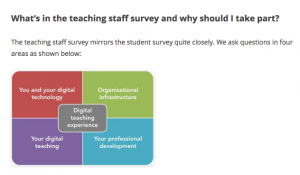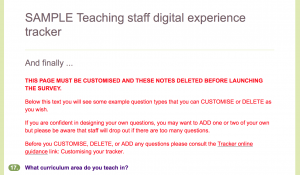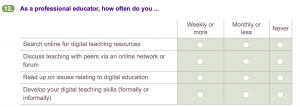If you’ve arrived here, you are helping us to pilot the teaching staff survey. Thank you for your interest and commitment!
This survey gives teaching staff a voice in the development of digital provision and support. For more information on the background and rationale, please see this blog post on developing the Staff tracker or this one on the pilot process. There is a landing page for teaching staff to help explain the project to staff in your organisation – and you are welcome to adapt any text from here to support your own communications.

We are only extending this opportunity to experienced users of the Student survey, and you’ll find most of the process is exactly the same. Please read at least the Essential information from the list below. If you’re familiar with the content of the Guides for the student tracker survey, you can just scroll through the rest of the information and pick out what you need.
The Guides
- Essential information about running the staff pilot
- Guide: Planning to use the tracker v17-18 – the overall process of planning and stakeholder engagement is the same as for the student survey, and you will have gone through it already in order to run that. You may want to use this Resource planning table to allocate time and staff resource to the different stages of the pilot process
- How to use the tracker in BOS v17-18 – the full technical guide with screen shots and links to BOS technical help. The system for the teaching staff survey is exactly the same, though the screenshots are all taken from the student survey so you will have to use your imagination: that’s why you are a pioneer 🙂
- Guide: Customising the tracker v17-18 – the technical process is the same but we have some new ideas on writing custom questions for teaching staff. Note that only users of the full version will have this option.
- Engaging staff – new guidance, including a landing page specifically for explaining the project to teaching staff. There is also separate guidance on uploading teaching staff data into trackers so you can send out personalised invitations and reminders.
- Guilde: analysing your data v17-18 – these general principles remain the same.
- NEW! Question by Question Guide (Staff) v17-18 – a brand new guide to analysing the data from your staff tracker.
- NEW! 360 degree Guide v17-18, allowing you to map your teaching staff findings against your student findings (all versions), and all of those findings against the organisational information you provided on sign-up. There is also a column of other sources of data you may have available to compare with your tracker findings.
Essential information about running the teaching staff pilot
- From the sign-up process we have chosen a number of pilot institutions across sectors and geographical areas.
- You will receive a master copy of the teaching staff survey, either the standard or the mini version, via your BOS dashboard. You will not be able to choose which version you receive. This is because we are pairing institutions of a similar size to see whether the mini version is (a) much easier to use and (b) not much less informative.
- To access your survey, log into BOS Online Surveys, toggle to the ‘Jisc staff digital experience tracker’ account (drop down, top right) and see your master version of the staff tracker. Please take a copy using the copy icon and re-name it in the DESIGN area by clicking on the large font survey name. You can create a simple ‘public survey name’ that your staff will see and a separate internal name for us to see on the dashboard. Please include your institution name and the version (mini or standard) in the internal survey name.
- We recommend that you use an email upload / distribution method to distribute the survey to your teaching staff (see uploading teaching staff data into trackers for details) but you can just distribute an open link. In this case, please can you let us know how many you invite to use the teaching staff tracker so that we can see what percentage respond.
- Follow the guidance on the rest of this page to customise, launch and promote the survey. Only users of the full version will be able to author their own custom questions.
- Staff trackers close on 31 May, when you will have access to all your data in BOS. You will not have access to benchmark data as you do with the student survey due to the small numbers involved and the risk of institutions being identified.
- You will be asked to complete a short evaluation form during June to help us improve the staff tracker for service. You will receive a private report on the findings of the pilot, which you can use to compare with your own data if you are interested and have a large enough sample to do this.
FAQs will appear here: if you ask, we will tell!
Customising the tracker for teaching staff

One of the most-liked features of the student tracker is the option to include custom questions. This means you can maximise the value of engagement and reduce survey load. BOS is the perfect tool to provide accurate data from anonymous survey responses and summarise it it at volume. You can compare the answers over different broad groups of staff, or track them over time. Note that only users of the full version will have this option.
What questions to ask?
- Read through the fixed questions carefully: standard staff tracker | mini staff tracker.
It sounds silly, but there really is no point repeating questions that are already in the question set. Remember that these questions have been carefully developed and piloted so even if you would have asked them in a different way, they are likely to provide useful and actionable data. Two of the questions asked in the staff survey are designed to be key indicators.
2. Review the questions you have asked staff in other surveys you have run. Which ones provided useful and actionable data? Which ones do you want to revisit, perhaps to monitor change over time? These are candidates to consider including.
3. Review current priorities for teaching staff use of digital technologies. For example:
- rolling out the use of a new learning and teaching system or environment
- introducing staff to new teaching spaces or classroom technologies
- improving (uptake of) digital staff development
- improving staff confidence in specific practices (e.g. teaching in a webinar environment) or teaching ideas (e.g. flipped classroom)
- encouraging use of a wider range of functions and features in digital learning platforms
- encouraging staff to produce their own professional web pages or videos
Framing one of these priority issues as a question allows you to baseline the current situation, while giving information about any new initiatives or support services that are available.
4. Think about recent research or professional reports into digital provision, especially from a teaching staff perspective. If you asked yourself ‘I wonder how that question would play out here’, now is the opportunity to ask it.
We don’t encourage you to ask staff to rate their skills, as this can be seen in a negative light – and you are very unlikely to get accurate responses. Instead you could ask staff about their ‘confidence to use‘ specific systems, or whether they have taken up specific training opportunities. Use the Digital discovery tool to help staff explore their own digital skills and practices.
Designing the questions
- We suggest you don’t add more than two or at most three questions, which could have a number of options (up to five). This is to reduce drop-out rates towards the end of the survey.
- Be influenced by how we have designed the fixed questions – for example using a common stem and answer options (e.g. agree | neutral | disagree) with a number of related prompts; or using a proven 7 point scale for ratings. Try to use similar language and question design to ensure a seamless experience for users.
- Test all new questions with your target users (not your e-learning team!). You can download a .pdf version from BOS and use this to test on paper, ideally with 5 or 6 users from different parts of the organisation! If you feel confident enough, ask users to ‘talk through’ the process of answering these questions so you can quickly identify any words that need clarifying or options that are not making sense.

Engaging teaching staff
You can choose your own target population: with this closed pilot we are more interested in quality feedback from each institution than in the overall number engaged. If you decide to offer the survey to all your teaching staff, we look forward to supporting you. If you want to start with a much smaller sub-set – perhaps where you can expect a higher percentage response rate – we are interested in your experience too.
For the pilot we have asked you to upload staff emails so that BOS can generate custom invitations to each individual. This means you can: track response rates and issue reminders; import other data about your respondents such as their department; compare your final dataset with other feedback you may have collected from your teaching staff. The process is fully explained in the guidance on uploading teaching staff data into trackers. Despite the advantages of this approach, you can simply distribute the URL directly from the launch pad if you prefer.
You will also need to write the text of the email(s) you send out to your potential participants and any other communications you plan to have with them e.g. printed flyers, social media messages, a web page. We suggest you emphasise that the organisation wants to hear their views.
There is now a landing page specifically for explaining the project to teaching staff. You could send this linke directly to teaching staff, or use some of the ideas to design your own communications. Teaching staff will expect a serious account of (a) why you are running the survey (b) how their data will be kept private and anonymous, and (c) what you will do with the findings. However, you can also use some of the ideas in the Guide: Engaging your learners – such as prize draws, live completions (perhaps at scheduled meetings and away-days), and getting students involved in championing the idea to teaching staff.
